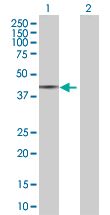Dhh overexpression 293T lysate (whole cell) (ab94180)
Overview
-
Product name
Dhh overexpression 293T lysate (whole cell)
See all Dhh lysates -
General notes
ab94180 is a 293T cell transfected lysate in which Human Dhh has been transiently over-expressed using a pCMV-Dhh plasmid. The lysate is provided in 1 x Sample Buffer. Note: For more details about how the transfected lysate was prepared view preparation notes
-
Tested applications
Suitable for: WBmore details
Properties
-
Mycoplasma free
Yes -
Form
Liquid -
Storage instructions
Shipped on dry ice. Upon delivery aliquot and store at -20ºC. Avoid freeze / thaw cycles. -
Storage buffer
Constituents: 0.01% Bromophenol blue, 2.3% Beta mercaptoethanol, 2% Sodium lauryl sulfate, 0.788% Tris HCl, 10% Glycerol (glycerin, glycerine) -
 Concentration information loading...
Concentration information loading... -
Research areas
-
Background
Function: Intercellular signal essential for a variety of patterning events during development. May function as a spermatocyte survival factor in the testes. Essential for testes development. Disease: Defects in DHH may be the cause of partial gonadal dysgenesis with minifascicular neuropathy 46,XY (PGD) [MIM:607080]. PGD is characterized by the presence of a testis on one side and a streak or an absent gonad at the other, persistence of Muellerian duct structures, and a variable degree of genital ambiguity. Defects in DHH may be the cause of complete pure gonadal dysgenesis 46,XY type (GDXYM) [MIM:233420]; also known as male-limited gonadal dysgenesis 46,XY. GDXYM is a type of hypogonadism in which no functional gonads are present to induce puberty in an externally female person whose karyotype is then found to be XY. The gonads are found to be non-functional streaks. Similarity: Belongs to the hedgehog family. PTM: The C-terminal domain displays an autoproteolysis activity and a cholesterol transferase activity. Both activities result in the cleavage of the full-length protein and covalent attachment of a cholesterol moiety to the C-terminal of the newly generated N-terminal fragment (N-product). This covalent modification appears to play an essential role in restricting the spatial distribution of the protein activity to the cell surface. The N-product is the active species in both local and long-range signaling, whereas the C-product has no signaling activity.
Images
-
ab94180 at 15µg/lane on an SDS-PAGE gel.
-
All lanes : Anti-Dhh antibody (ab67461) at 1/500 dilution
Lane 1 :Dhh overexpression 293T lysate (whole cell) (ab94180)
Lane 2 : 293T non-transfected lysate
Lysates/proteins at 25 µg per lane.
Secondary
All lanes : Goat Anti-mouse IgG (H and L) HRP conjugated at 1/2500 dilution










